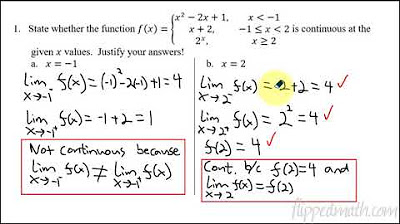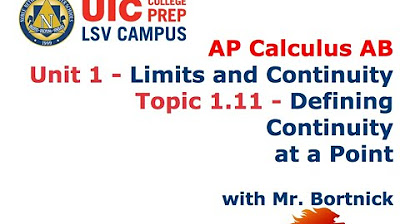Continuity!
TLDRThe video script delves into the concept of continuity in calculus, a fundamental assumption for most calculus operations. It explains that a function is considered continuous if it can be drawn without lifting the pencil, indicating no breaks, holes, or jumps. The script outlines three criteria for a function to be continuous at a point: the function must be defined at that point, the limit as X approaches that point must exist, and the function value must equal the limit. Using examples, including polynomial, rational, and piecewise functions, the video illustrates how to determine continuity. It emphasizes that polynomials are always continuous, while rational functions may have discontinuities where the denominator is zero. For piecewise functions, continuity depends on the agreement of limits from the left and right. The video concludes with a checklist for assessing continuity, reinforcing the importance of understanding this foundational concept for calculus.
Takeaways
- 📝 Continuity is crucial in calculus as most operations assume the function is continuous.
- 🔍 A function is considered continuous if you don't have to lift your pencil while drawing it, indicating no breaks or jumps.
- 🚫 Points of discontinuity occur when you must lift your pencil, such as at vertical asymptotes or holes in the function.
- 🌐 A continuous function has zero points of discontinuity across its entire domain.
- 📈 A function is continuous at a point 'a' if it is defined there, the limit exists as 'x' approaches 'a', and the function value equals the limit.
- 🔄 For piecewise functions, the continuity must be checked separately for each piece and at the points where the function changes.
- 📊 Polynomial functions are always continuous everywhere, while rational functions may have discontinuities when the denominator is zero.
- 🔍 To check continuity, evaluate the function at the point of interest, find the limit from both the left and right as 'x' approaches that point, and ensure they match the function value.
- ✅ If all three conditions for continuity are met (function defined, limit exists, function value equals limit), the function is continuous at that point.
- ❌ If any condition fails, the function is discontinuous at that point.
- 📚 Understanding continuity is essential for further studies in calculus and correctly applying limit concepts.
Q & A
What is the basic idea behind the concept of continuity in calculus?
-The basic idea behind continuity in calculus is that a function is continuous if you can draw its graph without lifting your pencil at any point. This means there are no breaks, holes, or jumps in the graph of the function.
What are points of discontinuity?
-Points of discontinuity are the specific points on the graph of a function where the function is not defined, has a hole, or has a vertical asymptote. At these points, you would have to lift your pencil while drawing the graph of the function.
How can we formally determine if a function is continuous at a particular point?
-A function is formally continuous at a point x=a if three conditions are met: (1) the function is defined at x=a (f(a) is defined), (2) the limit as x approaches a of the function exists, and (3) the function value at x=a equals the limit of the function as x approaches a (f(a) = lim(x→a) f(x)).
What is the significance of polynomial functions in terms of continuity?
-Polynomial functions are significant in terms of continuity because they are continuous everywhere. There are no points of discontinuity in a polynomial function, which makes them easy to work with in calculus.
What about rational functions? Are they always continuous?
-Rational functions, which are ratios of two polynomials, are generally continuous except where the denominator is zero, which creates a vertical asymptote or a removable discontinuity (a hole in the graph). Everywhere else, the function is continuous.
How do you determine the continuity of a piecewise function at a specific point?
-To determine the continuity of a piecewise function at a specific point, you must check if the function is defined at that point, if the limit exists as x approaches that point (which requires agreement of the left and right limits), and if the function value at that point equals the limit of the function as x approaches that point.
What is the intuition behind the three criteria for a function to be continuous at a point?
-The three criteria ensure that there are no abrupt changes in the function's value or graph at the point in question. They prevent holes, vertical asymptotes, jumps in value, and ensure that the function's value at the point matches the value that the function's limit predicts.
What happens if any of the three criteria for continuity are not met at a point?
-If any of the three criteria for continuity are not met at a point, the function is considered discontinuous at that point. The function must satisfy all three criteria to be continuous at a given point.
What is a removable discontinuity?
-A removable discontinuity is a type of point of discontinuity where the function is not defined at a certain point, but the graph has a hole that can be 'filled in' to make the function continuous. This often occurs when a function has a form that results in a division by zero, which can be simplified to avoid the undefined expression.
How does the concept of limits play a crucial role in defining continuity?
-The concept of limits is crucial in defining continuity because it provides a way to mathematically describe the behavior of a function as it approaches a certain point. The limit ensures that the function's behavior from both the left and the right as it approaches the point is the same, which is necessary for the function to be continuous at that point.
What is the significance of the left-hand limit and the right-hand limit in determining the continuity of a function?
-The left-hand limit and the right-hand limit are significant because they represent the behavior of the function as it approaches a point from the left side and the right side, respectively. For a function to be continuous at a point, these two limits must agree and also equal the function's value at that point.
Can a function be continuous at a point where it has a vertical asymptote?
-No, a function cannot be continuous at a point where it has a vertical asymptote. A vertical asymptote represents a point where the function's value becomes infinitely large in a finite amount of change in the input variable, which violates the definition of continuity.
Outlines
📐 Understanding Continuity in Calculus
The video begins by emphasizing the importance of continuity in calculus, as most operations assume the function in question is continuous. The presenter explains that continuity can be visualized by imagining drawing a function's graph without lifting the pencil. This intuitive idea is then formally defined with three conditions: the function must be defined at the point, the limit as x approaches that point must exist and agree from both sides, and the function value at the point must equal the limit. The video uses examples to illustrate points of discontinuity, such as holes or vertical asymptotes, and how these points require lifting the pencil.
🔍 Formal Definition and Example of Continuity
The presenter provides a checklist for determining if a function is continuous at a given point. This involves checking if the function is defined at the point, if the limit exists as x approaches that point (which requires agreement from both left and right sides), and if the function value equals the limit. An example is worked through using these criteria to test the continuity of the function f(x) = (x - 3) / (x - 2) at x = 4, which is found to be continuous, and at x = 2, which is not continuous due to a vertical asymptote.
🧩 Continuity in Piecewise Functions
The video moves on to discuss continuity in piecewise functions, which can be more complex. The presenter explains that polynomial functions are always continuous, while rational functions may have discontinuities when the denominator is zero. For piecewise functions, continuity at a point requires checking the function's definition and the existence of the limit from both sides. An example of a piecewise function is given, and the presenter demonstrates how to check for continuity at x = 0 by evaluating the function and its limits from the left and right.
🏁 Summary of Continuity Conditions
The video concludes with a summary of the conditions for a function to be considered continuous at a point. A function is continuous if it is defined at the point, the limit exists as x approaches that point (with agreement from both sides), and the function value matches the limit. The presenter reiterates that a function is only considered continuous if all three conditions are met, and failing any one condition results in a discontinuous function at that point. The video ends with encouragement for viewers to tackle homework problems and seek help if needed.
Mindmap
Keywords
💡Continuity
💡Function
💡Limit
💡Discontinuity
💡Rational Function
💡Polynomial Function
💡Piecewise Function
💡Asymptote
💡Hole
💡Domain
💡Graph
Highlights
Continuity is a fundamental concept in calculus, assuming that the function being worked on is continuous.
A function is considered continuous if you can draw it without lifting your pencil off the paper.
Points where you have to lift the pencil are known as points of discontinuity.
A continuous function is defined as having zero points of discontinuity.
For a function to be continuous at a point x=a, it must satisfy three conditions: the function is defined at a, the limit exists as x approaches a, and the function value equals the limit.
The first criterion for continuity prevents functions with holes or vertical asymptotes at x=a.
The second criterion ensures the limit from both sides of x=a agrees, preventing functions with jumps.
The third criterion checks if the function value at x=a matches the limit, avoiding situations where the function does not align with the limit.
An example is provided to illustrate how to determine if a function is continuous at a given point.
A checklist is used to verify the continuity of a function at a point: existence at the point, limit existence, and value equality with the limit.
Polynomial functions are always continuous everywhere, with no points of discontinuity.
Rational functions are mostly continuous but can have discontinuities when the denominator equals zero.
Piecewise functions require checking the function's definition and limits from both sides of the breakpoint.
The function f(x) = x^2 - 4 when x ≤ 0 and 3/4x^2 - 3 when x > 0 is analyzed for continuity at x=0.
For piecewise functions, the limit from the left must equal the limit from the right for the function to be continuous at a breakpoint.
The function is only considered continuous if all three criteria are met; failure of any one results in discontinuity at that point.
Graphically, a function is continuous at a point if there are no vertical asymptotes or holes in the graph at that point.
The importance of understanding continuity is emphasized for its role in calculus operations and function analysis.
Transcripts
5.0 / 5 (0 votes)
Thanks for rating:





